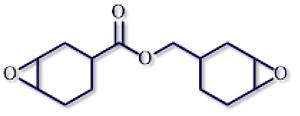Cycloaliphatic epoxy resin refers to a low molecular weight compound containing alicyclic epoxy groups. It is not a polymer itself, but it can generate a three-dimensional structure polymer with excellent performance after reacting with a curing agent. Due to its unique structure, that is, the epoxy group is directly connected to the saturated alicyclic structure, rather than being connected to the benzene ring through an ether bond like bisphenol A epoxy resin, it has special performance characteristics.

Small molecular weight, low viscosity, good transparency.
High epoxy value, high cross-linking density of the cured product, high glass transition temperature, and good heat resistance.
There is no benzene ring structure and hydroxyl group in the molecule, and the cycloaliphatic epoxide has excellent UV resistance and weather resistance.
Low chlorine content, low dielectric constant, and good epoxy electrical insulation performance.
Low volatility, low toxicity, and low irritation.
It has a large amount of epoxy resin, is easily miscible with it, and has low viscosity after miscibility. This specialty resin chemical can be modified by adding more fillers, which is beneficial to reduce costs.
Long service life, low heat release, and easy operation.
The curing temperature is generally high and the curing cycle is long.
Common anhydride curing agents include tetrahydrophthalic anhydride, hexahydrophthalic anhydride, methyl tetrahydrophthalic anhydride, methyl hexahydrophthalic anhydride, methyl nadic anhydride, etc. Since methyl hexahydrophthalic anhydride is a transparent liquid at room temperature and has the characteristics of low viscosity, light color, easy operation, and excellent curing performance, methyl hexahydrophthalic anhydride is usually used as a curing agent for thermal curing of cycloaliphatic epoxy resins.
After the cycloaliphatic epoxy resin TTA21P is cured with methyl hexahydrophthalic anhydride, the cured product has the following main performance characteristics:
Excellent heat resistance: high heat deformation temperature and high glass transition temperature (Tg), which can reach about 200-210℃.
Excellent insulation performance: especially the insulation performance at high temperature, such as low dielectric constant and dielectric loss, high volume resistivity, and excellent tracking resistance.
Good weather resistance and yellowing resistance.
Item | Aliphatic Epoxy (TTA21P) | Bisphenol A Epoxy (E51) | |||
Dielectric Constant | 25°C | 3.2-3.5 | 3.1-3.5 | ||
150°C | 5.3-5.5 | 6.2-6.6 | |||
Dielectric Loss (%) | 25°C | 0.3-0.5 | 0.5-0.7 | ||
150°C | 6.3-7.3 | 6.8-7.8 | |||
Volume Resistivity | 25°C | 1015-1016 | 1015-1016 | ||
150°C | About 1013 | 10 | |||
| Glass transition temperature Tg (℃) | 190-220 | 100-130 | |||
| Tracking resistance (2.5kV/s) | >2000 | 1000-200 | |||
| No change in surface appearance | Severe carbonization on the surface | ||||
| Weather resistance (4 years outdoor) | Tensile strength (Mpa) | 48(before) | 38(after) | 80(before) | 13(after) |
| Elongation(%) | 2 | 1.5 | 6.2 | 0.6 | |
| Exterior | Transparent | Yellowish | Yellowish brown | Opaque | |
In summary, the combination of cycloaliphatic epoxy resin and acid anhydride can be used in many fields such as LED packaging, electrical casting, insulation impregnation, insulation potting and composite materials.